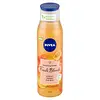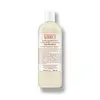Nivea Fresh Blends Apricot, Mango, Rice Milk Shower Gel Versus Kiehl's Bath and Shower Liquid Body Cleanser
What's inside
What's inside
 Key Ingredients
Key Ingredients

 Benefits
Benefits

 Concerns
Concerns

 Ingredients Side-by-side
Ingredients Side-by-side

Water
Skin ConditioningSodium Laureth Sulfate
CleansingCocamidopropyl Betaine
CleansingCoco-Glucoside
CleansingSodium Chloride
MaskingPrunus Amygdalus Dulcis Oil
Skin ConditioningMangifera Indica Juice
Skin ConditioningPrunus Armeniaca Juice
MoisturisingOryza Sativa Extract
AbsorbentGlycerin
HumectantBisabolol
MaskingPropylene Glycol
HumectantSorbitol
HumectantCitric Acid
BufferingGlycol Distearate
EmollientLaureth-4
EmulsifyingSodium Hydroxide
BufferingXanthan Gum
EmulsifyingCetearyl Glucoside
EmulsifyingGlyceryl Stearate Se
EmulsifyingTrideceth-9
EmulsifyingSodium Sulfate
Denatonium Benzoate
MaskingSodium Benzoate
MaskingTrisodium EDTA
Phenoxyethanol
PreservativePotassium Sorbate
PreservativeBenzoic Acid
MaskingDehydroacetic Acid
PreservativeEthylhexylglycerin
Skin ConditioningGeraniol
PerfumingLinalool
PerfumingParfum
MaskingCI 15985
Cosmetic ColorantWater, Sodium Laureth Sulfate, Cocamidopropyl Betaine, Coco-Glucoside, Sodium Chloride, Prunus Amygdalus Dulcis Oil, Mangifera Indica Juice, Prunus Armeniaca Juice, Oryza Sativa Extract, Glycerin, Bisabolol, Propylene Glycol, Sorbitol, Citric Acid, Glycol Distearate, Laureth-4, Sodium Hydroxide, Xanthan Gum, Cetearyl Glucoside, Glyceryl Stearate Se, Trideceth-9, Sodium Sulfate, Denatonium Benzoate, Sodium Benzoate, Trisodium EDTA, Phenoxyethanol, Potassium Sorbate, Benzoic Acid, Dehydroacetic Acid, Ethylhexylglycerin, Geraniol, Linalool, Parfum, CI 15985
Water
Skin ConditioningDisodium Laureth Sulfosuccinate
CleansingGlycerin
HumectantCocamidopropyl Betaine
CleansingSodium Cocoamphoacetate
CleansingPPG-5-Ceteth-20
EmulsifyingSodium Lauryl Sulfoacetate
CleansingDecyl Glucoside
CleansingSodium Chloride
MaskingSucrose Cocoate
EmulsifyingPEG-150 Pentaerythrityl Tetrastearate
EmulsifyingParfum
MaskingSodium Hydroxide
BufferingCaprylyl Glycol
EmollientCitric Acid
BufferingPEG-6 Caprylic/Capric Glycerides
EmulsifyingPropylene Glycol
HumectantSalicylic Acid
MaskingLimonene
PerfumingBenzoic Acid
MaskingBenzyl Alcohol
PerfumingTrisodium Ethylenediamine Disuccinate
Linalool
PerfumingBenzyl Salicylate
PerfumingAlpha-Isomethyl Ionone
PerfumingGeraniol
PerfumingAloe Barbadensis Leaf Juice Powder
Skin ConditioningCitronellol
PerfumingHexyl Cinnamal
PerfumingBenzyl Cinnamate
PerfumingSodium PCA
HumectantCitrus Grandis Fruit Extract
AstringentHydrolyzed Soy Protein
HumectantSorbitol
HumectantWater, Disodium Laureth Sulfosuccinate, Glycerin, Cocamidopropyl Betaine, Sodium Cocoamphoacetate, PPG-5-Ceteth-20, Sodium Lauryl Sulfoacetate, Decyl Glucoside, Sodium Chloride, Sucrose Cocoate, PEG-150 Pentaerythrityl Tetrastearate, Parfum, Sodium Hydroxide, Caprylyl Glycol, Citric Acid, PEG-6 Caprylic/Capric Glycerides, Propylene Glycol, Salicylic Acid, Limonene, Benzoic Acid, Benzyl Alcohol, Trisodium Ethylenediamine Disuccinate, Linalool, Benzyl Salicylate, Alpha-Isomethyl Ionone, Geraniol, Aloe Barbadensis Leaf Juice Powder, Citronellol, Hexyl Cinnamal, Benzyl Cinnamate, Sodium PCA, Citrus Grandis Fruit Extract, Hydrolyzed Soy Protein, Sorbitol
Ingredients Explained
These ingredients are found in both products.
Ingredients higher up in an ingredient list are typically present in a larger amount.
Benzoic Acid is used to preserve and adjust the pH of products.
The antimicrobial property of Benzoic Acid helps elongate a product's shelf life. Its main role is to reduce fungi growth and is not found to be effective at fighting bacteria. Therefore Benzoic Acid is always added along with other preservatives.
In its pure form, Benzoic Acid looks like a white crystalline solid. It has slight solubility in water.
The name of Benzoic Acid comes from gum benzoin, which used to be the sole source of deriving this ingredient. Benzoic Acid is the most simple aromatic carboxylic acid.
Benzoic Acid is naturally occuring in strawberries, mustard, cinnamon, and cloves. It has a slight scent but is not considered to be a fragrance.
Learn more about Benzoic AcidCitric Acid is an alpha hydroxy acid (AHA) naturally found in citrus fruits like oranges, lemons, and limes.
Like other AHAs, citric acid can exfoliate skin by breaking down the bonds that hold dead skin cells together. This helps reveal smoother and brighter skin underneath.
However, this exfoliating effect only happens at high concentrations (20%) which can be hard to find in cosmetic products.
Due to this, citric acid is usually included in small amounts as a pH adjuster. This helps keep products slightly more acidic and compatible with skin's natural pH.
In skincare formulas, citric acid can:
While it can provide some skin benefits, research shows lactic acid and glycolic acid are generally more effective and less irritating exfoliants.
Most citric acid used in skincare today is made by fermenting sugars (usually from molasses). This synthetic version is identical to the natural citrus form but easier to stabilize and use in formulations.
Read more about some other popular AHA's here:
Learn more about Citric AcidCocamidopropyl Betaine is a fatty acid created by mixing similar compounds in coconut oil and dimethylaminopropylamine, a compound with two amino groups.
This ingredient is a surfactant and cleanser. It helps gather the dirt, pollutants, and other impurities in your skin to be washed away. It also helps thicken a product and make the texture more creamy.
Being created from coconut oil means Cocamidopropyl Betaine is hydrating for the skin.
While Cocamidopropyl Betaine was believed to be an allergen, a study from 2012 disproved this. It found two compounds in unpure Cocamidopropyl Betaine to be the irritants: aminoamide and 3-dimethylaminopropylamine. High-grade and pure Cocamidopropyl Betaine did not induce allergic reactions during this study.
Learn more about Cocamidopropyl BetaineGeraniol is used to add fragrance/parfum to a product. It is the main component of citronellol. It is a monoterpenoid and an alcohol.
Monoterpenes are naturally found in many parts of different plants.
Geraniol can be found in many essential oils including Rose Oil and Citronella Oil. The scent of Geraniol is often described as "rose-like". Many foods also contain Geraniol for fruit flavoring.
Geraniol can irritate the skin when exposed to air. However, irritation depends on the ability of geraniol to penetrate into the skin. In general, geraniol is not able to penetrate skin easily.
Geraniol is colorless and has low water-solubility. However, it is soluble in common organic solvents.
Like citronellol, it is a natural insect repellent.
2,6-Octadien-1-ol, 3,7-dimethyl-, (2E)-
Learn more about GeraniolGlycerin is already naturally found in your skin. It helps moisturize and protect your skin.
A study from 2016 found glycerin to be more effective as a humectant than AHAs and hyaluronic acid.
As a humectant, it helps the skin stay hydrated by pulling moisture to your skin. The low molecular weight of glycerin allows it to pull moisture into the deeper layers of your skin.
Hydrated skin improves your skin barrier; Your skin barrier helps protect against irritants and bacteria.
Glycerin has also been found to have antimicrobial and antiviral properties. Due to these properties, glycerin is often used in wound and burn treatments.
In cosmetics, glycerin is usually derived from plants such as soybean or palm. However, it can also be sourced from animals, such as tallow or animal fat.
This ingredient is organic, colorless, odorless, and non-toxic.
Glycerin is the name for this ingredient in American English. British English uses Glycerol/Glycerine.
Learn more about GlycerinLinalool is a fragrance and helps add scent to products. It's derived from common plants such as cinnamon, mint, citrus, and lavender.
Like Limonene, this ingredient oxidizes when exposed to air. Oxidized linalool can cause allergies and skin sensitivity.
This ingredient has a scent that is floral, spicy tropical, and citrus-like.
Learn more about LinaloolParfum is a catch-all term for an ingredient or more that is used to give a scent to products.
Also called "fragrance", this ingredient can be a blend of hundreds of chemicals or plant oils. This means every product with "fragrance" or "parfum" in the ingredients list is a different mixture.
For instance, Habanolide is a proprietary trade name for a specific aroma chemical. When used as a fragrance ingredient in cosmetics, most aroma chemicals fall under the broad labeling category of “FRAGRANCE” or “PARFUM” according to EU and US regulations.
The term 'parfum' or 'fragrance' is not regulated in many countries. In many cases, it is up to the brand to define this term.
For instance, many brands choose to label themselves as "fragrance-free" because they are not using synthetic fragrances. However, their products may still contain ingredients such as essential oils that are considered a fragrance by INCI standards.
One example is Calendula flower extract. Calendula is an essential oil that still imparts a scent or 'fragrance'.
Depending on the blend, the ingredients in the mixture can cause allergies and sensitivities on the skin. Some ingredients that are known EU allergens include linalool and citronellol.
Parfum can also be used to mask or cover an unpleasant scent.
The bottom line is: not all fragrances/parfum/ingredients are created equally. If you are worried about fragrances, we recommend taking a closer look at an ingredient. And of course, we always recommend speaking with a professional.
Learn more about ParfumPropylene Glycol is an odorless, colorless liquid. As a humectant, it helps skin retain moisture. It also aids in delivering active ingredients.
Another role of this ingredient is preventing a product from melting or freezing. Propylene glycol also adds antimicrobrial properties to a product, elongating product lifespan.
This ingredient is considered an organic alcohol and commonly added into both cosmetics and foods.
Those with sensitive skin or conditions may develop a rash when using this ingredient.
Learn more about Propylene GlycolChances are, you eat sodium chloride every day. Sodium Chloride is also known as table salt.
This ingredient has many purposes in skincare: thickener, emulsifier, and exfoliator.
You'll most likely find this ingredient in cleansers where it is used to create a gel-like texture. As an emulsifier, it also prevents ingredients from separating.
There is much debate on whether this ingredient is comedogenic. The short answer - comedogenic ratings don't tell the whole story. Learn more about comegodenic ratings here.
The concensus about this ingredient causing acne seems to be divided. Research is needed to understand if this ingredient does cause acne.
Scrubs may use salt as the primary exfoliating ingredient.
Learn more about Sodium ChlorideSodium Hydroxide is also known as lye or caustic soda. It is used to adjust the pH of products; many ingredients require a specific pH to be effective.
In small amounts, sodium hydroxide is considered safe to use. However, large amounts may cause chemical burns due to its high alkaline.
Your skin has a natural pH and acid mantle. This acid mantle helps prevent harmful bacteria from breaking through. The acid mantle also helps keep your skin hydrated.
"Alkaline" refers to a high pH level. A low pH level would be considered acidic.
Learn more about Sodium HydroxideSorbitol is a sugar alcohol. It is a hydrating and moisturizing agent created from the reduction process of glucose.
Most sorbitol is usually made from potato starch. It is also found in fruits such as apples and pears.
As a humectant, Sorbitol helps draw water to the skin. This helps keep the skin hydrated. Sorbitol also helps create a thicker texture in products. You might find sorbitol in your toothpaste and other gels.
It is a non-irritating ingredient that is great for those with dry skin.
Sorbitol is a prebiotic. It helps promote the growth of healthy bacteria on your skin. The bacteria on your skin form a microbiome. This microbiome helps protect your skin from infection and harmful bacteria.
Learn more about SorbitolWater. It's the most common cosmetic ingredient of all. You'll usually see it at the top of ingredient lists, meaning that it makes up the largest part of the product.
So why is it so popular? Water most often acts as a solvent - this means that it helps dissolve other ingredients into the formulation.
You'll also recognize water as that liquid we all need to stay alive. If you see this, drink a glass of water. Stay hydrated!
Learn more about Water